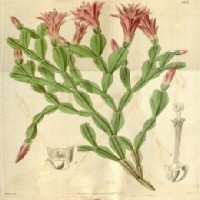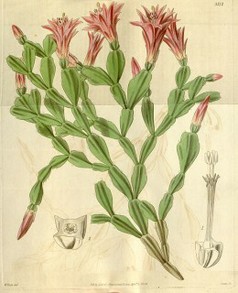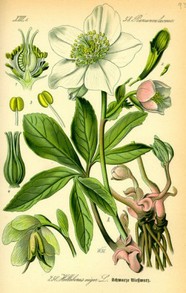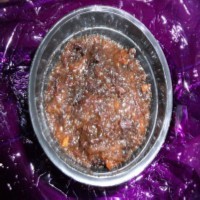Traditional Christmas Flowers
Christmas is a time that people like to decorate their homes and the villages, towns and cities they live in. It is a time for colour to stand out against the bleakness of winter or the single colour of snow. Most trees have lost their leaves and most flowering plants have died back but not everything is dormant.
Flowers and various other plants have been a traditional part of Xmas decorations perhaps ever since the seasonal event was celebrated. Holly and Ivy are evergreens that date back a long time but the Christmas Cactus is a more modern plant that is cultivated because it flowers at this time of year.

Christmas flowers are a gift of the season
by BardofEly
There are a lot of flowers and plants and trees that are associated with Christmas and this keeps the Winter Solstice festival linked in with nature and its pagan roots.
Christmas Cactus
There are several species and many cultivars the Christmas Cactus. The botanical name for a commonly grown one of these is Zygocactus truncatus or Schlumbergera truncata. It was in cultivation by 1818.
This plant is a true cactus but very different from those prickly types that grow in deserts and dry areas. The Christmas Cactus is an epiphyte that grows in humus that has accumulated in forks and crevices in trees and in rocks.
It comes from the mountains of Brazil and a moist tropical climate and needs a lot more water than conventional cacti. Given the right care though the Christmas Cactus will last for many years and can grow into quite a sizeable plant. It is also easy to take cuttings from to start more plants growing.
Christmas Cactus has flat jointed stems that rake the form of segments that droop downwards from a central woody trunk. There are no leaves although these strange succulent stems look a bit like leaves. At the ends they form flower-buds.
The Christmas Cactus really does flower around Christmas in the UK and Europe though it may flower at other times in other parts of the world. It has beautiful rosy-pink, red, orange, yellow, purple or white flowers depending on the variety.
Christmas Cactus on Amazon
The Poinsettia
The Poinsettia (Euphorbia pulcherrima) is a very popular flower for Christmas. So much so that they have a Poinsettia Day in many parts and there and in other countries it gets planted out in large numbers as a decorative ornamental plant for the Christmas Season.
The Poinsettia has bright flaming red bracts around its tiny true flowers and these red bracts make it very apt for Christmas. Red is the colour of the clothes of Father Christmas, of Rudolph the Red-nosed Reindeer's nose and of the berries on the Holly tree. In warm enough conditions the Poinsettia will form a small tree or a very large bush too.
A subtropical plant from Mexico originally, the Poinsettia is sold as an indoor plant in the UK and other colder countries, but in subtropical areas they are planted out in flower borders to give plenty of seasonal colour. It is one of the most popular Christmas flowers in the world today that is grown to provide colourful festive floral decorations.
Christmas Rose
The Christmas Rose is actually the Black Hellebore (Helleborus niger) and not in the Rosaceae (Rose family) but in the Ranunculaceae (Buttercup family). It is a perennial herb with large flowers and blooms in winter so is often in flower on Xmas Day.
The Christmas Rose has five petals although technically these are sepals and only look like petals. The flowers are quite big and usually white although there are pink cultivated varieties and double-flowered forms. It has evergreen leaves.
There are many other species in the Hellebore genus and many of these are also cultivated for their ornamental value. This means that many hybrids and cultivars are also available in all sorts of colours.
The Christmas Rose is a Xmas flower that brightens up our gardens in the Festive Season. It will carry on flowering right through until spring though.
This plant is also included in Herbs of the Northern Shaman.
Herbs of the Northern Shaman
 | Herbs of the Northern Shaman: A Guide to Mind-altering Plants of the Northern Hemisphere Moon Books |
Holly
The Holly is an small evergreen tree that is perhaps too well known to need any description. There are male and female trees and the latter can be covered in plenty of shiny red berries in a good year.
The red Holly berries stand out well in contrast against the dark green prickly and leathery leaves. Small branches and sprigs of Holly are often cut and brought indoors as decorations at Christmas and of course the Holly is often depicted on Christmas cards and midwinter scenes.
The Holly is a tree that can stand up to the coldest of winters and its strong prickly leaves and bright coloured berries symbolises strength and winter cheer,
The Holly is an important tree for Pagans as well as being part of the Christian celebrations. It was and is sacred to the Druids and associated with the Winter Solstice.
The Holly is of course also in the well-known and much loved Christmas carol The Holly and the Ivy with the lines "The Holly bears a berry as red as any blood, and Mary bore sweet Jesus Chrst to do poor sinners good."
Holly and the Ivy
Ivy
Ivy (Hedera helix) is an evergreen creeping plant that like the Holly can withstand the cold of winter. It grows up walls and trees and is often seen growing near to where the Holly itself is growing.
Earlier in the autumn the Ivy's flowers are a welcome source of nectar for butterflies before they hibernate. The Ivy produces greenish-back berries after it finishes flowering.
The berries of Ivy are eaten by some types of bird so produce a real Christmas gift for them if snow and ice make it hard for them to find food at this time of year.
The Ivy is in the traditional carol The Holly and the Ivy already mentioned.
Mistletoe and Wine
Mistletoe and Wine on Amazon
 | Dark Side of the Tune: Popular Music and Violence (Ashgate Popular and Folk Music) Written against the academically dominant but simplistic romanticization of popular music as a positive force, this book focuses on the 'dark side' of the subject. It is a pione... Ashgate |
Mistletoe
The Mistletoe (Viscum album) is a strange evergreen but parasitic plant that has become associated with Christmas and with the Pagan celebrations of Winter Solstice. It feeds directly from the sap of a host tree that it had started its growth on when a seed was lodged there by a bird.
Mistletoe grows high in many types of tree including Apple, Hawthorn, Poplar and Ash. When in olden days it was discovered in the Oak byDruids it was regarded as a particularly magical and sacred plant because it was not often found in this tree.
The Druids held it in very high regard because it was a herb that was neither of the earth or the air. Its white berries were thought to be milky like semen and were therefore it was a symbol of fertility. Mistletoe was believed to have many health-giving properties and was regarded as a panacea as well as a magical herb. It was gathered with great ceremony at the time of Winter Solstice. The plant is included in my book Herbs of the Northern Shaman.
Because of its mystical associations with fertility Mistletoe is still used at Christmas for couples to kiss under. This is an example of where Pagan traditions have survived and crept into Christian religious celebrations today.
Mistletoe is also contained in the lyrics of a hit single by Sir Cliff Richard: Mistletoe and Wine .
Mistletoe is one of the evergreen plants that definitely bring their own cheery magic into the cold and darkness of winter.
Copyright © 2012 Steve Andrews. All Rights Reserved.
You might also like
Christmas pudding, Father Christmas, Christmas films and happy...We all have Christmas memories and things we like about Christmas
Christmas in Tenerife has Santa Claus tooTenerife is a subtropical island with palm trees and warm sunshine even in wi...







 What to see and do in Icod de los Vinoson 06/28/2016
What to see and do in Icod de los Vinoson 06/28/2016
 Herbs of the Sun, Moon and Planets is the follow up to Herbs of the Northern Shamanon 10/03/2015
Herbs of the Sun, Moon and Planets is the follow up to Herbs of the Northern Shamanon 10/03/2015
 Music for Pagan Weddingson 03/07/2013
Music for Pagan Weddingson 03/07/2013
 Los Silos is part of Tenerife’s Low Island or Isla Bajaon 02/23/2013
Los Silos is part of Tenerife’s Low Island or Isla Bajaon 02/23/2013



Comments